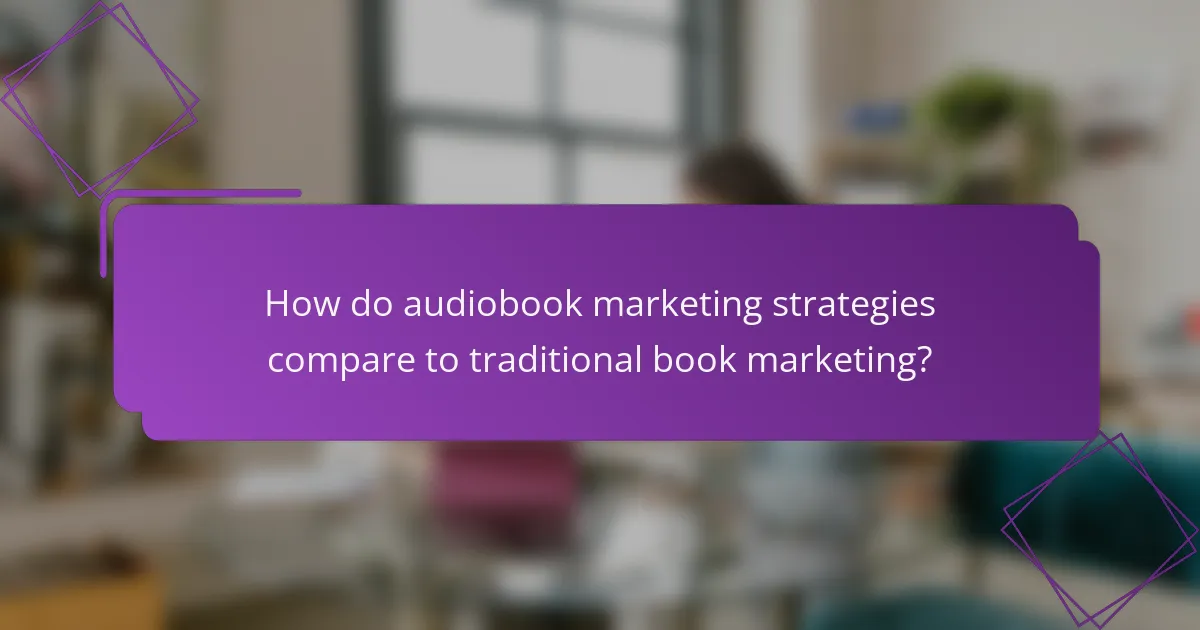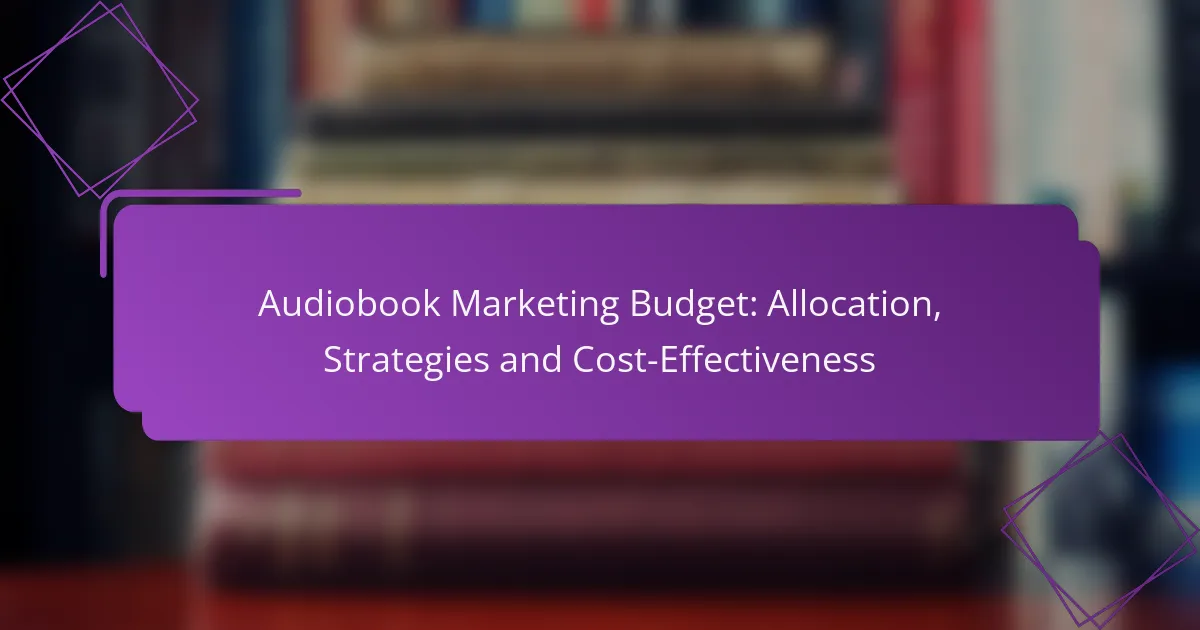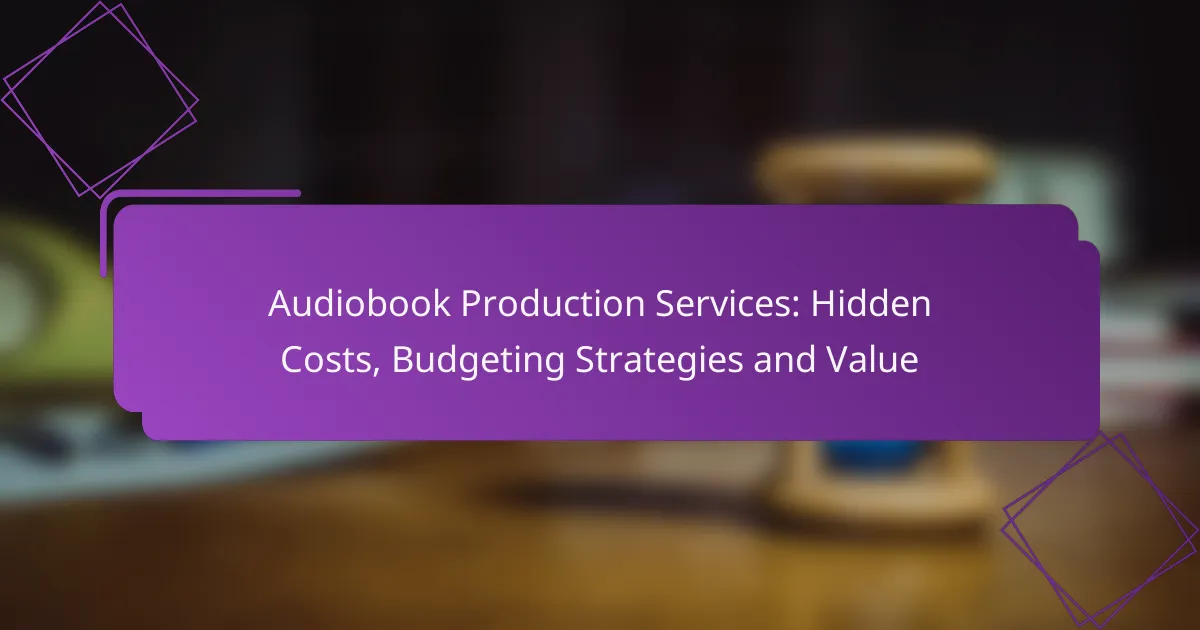Effectively allocating an audiobook marketing budget is crucial for maximizing exposure and driving sales. By understanding your audience and analyzing past performance, you can set clear goals that ensure your funds are spent wisely. Employing targeted strategies such as social media advertising and influencer partnerships will enhance visibility, while being mindful of the varied costs associated with production and promotion will help maintain cost-effectiveness.

How to allocate an audiobook marketing budget effectively?
To allocate an audiobook marketing budget effectively, identify key areas that will maximize exposure and sales. Focus on understanding your audience, analyzing past performance, and setting clear goals to ensure funds are spent wisely.
Determine target audience demographics
Understanding your target audience demographics is crucial for effective budget allocation. Identify factors such as age, gender, location, and interests to tailor your marketing strategies. For instance, if your audiobook appeals to young adults, consider platforms popular among that age group, like social media or streaming services.
Utilize surveys or analytics tools to gather data on your audience. This information will help you prioritize spending on channels that resonate most with your listeners, ensuring a higher return on investment.
Analyze previous marketing performance
Reviewing past marketing performance provides insights into what strategies worked and what didn’t. Look at metrics such as conversion rates, engagement levels, and sales figures from previous campaigns. This analysis allows you to allocate funds to the most effective tactics.
Consider using A/B testing for different marketing approaches to refine your strategies further. By understanding which campaigns yielded the best results, you can make informed decisions on budget distribution going forward.
Set clear marketing goals
Establishing clear marketing goals is essential for effective budget allocation. Define what success looks like for your audiobook, whether it’s increasing sales, boosting brand awareness, or growing your listener base. Specific, measurable goals will guide your spending decisions.
For example, if your goal is to increase sales by 20% in the next quarter, allocate a larger portion of your budget to high-impact strategies like targeted ads or influencer partnerships that can drive immediate results.
Consider competitive landscape
Understanding the competitive landscape helps you position your audiobook effectively and allocate resources accordingly. Research your competitors’ marketing strategies, pricing, and promotional activities to identify gaps and opportunities in the market.
By analyzing competitors, you can determine where to invest your budget for maximum impact. For instance, if competitors are heavily investing in social media ads, consider whether to match or differentiate your approach to stand out.
Utilize marketing budget templates
Using marketing budget templates can streamline your planning and ensure all aspects of your campaign are covered. Templates help you categorize expenses, track spending, and adjust allocations as needed. They provide a clear overview of your budget, making it easier to identify areas that may require more funding.
Look for customizable templates that fit your specific needs, or create your own based on previous campaigns. Regularly update your budget to reflect actual spending and adjust your strategies accordingly for optimal effectiveness.

What are the most effective audiobook marketing strategies?
Effective audiobook marketing strategies focus on leveraging digital platforms and targeted outreach to maximize visibility and sales. Key approaches include social media advertising, email marketing, influencer partnerships, and search engine optimization.
Leverage social media advertising
Social media advertising is a powerful way to reach potential listeners where they spend their time online. Platforms like Facebook, Instagram, and TikTok allow for targeted ads based on user interests, demographics, and behaviors, making it easier to connect with your ideal audience.
Consider allocating a portion of your budget to create visually appealing ads that highlight key aspects of your audiobook, such as compelling quotes or engaging cover art. Testing different ad formats, such as video or carousel ads, can help identify what resonates best with your audience.
Implement email marketing campaigns
Email marketing remains a cost-effective strategy for promoting audiobooks. Building a mailing list of interested readers allows you to send personalized updates, exclusive content, and promotional offers directly to their inboxes.
Focus on creating engaging newsletters that include sneak peeks, author interviews, or listener testimonials. Segment your audience based on their preferences to tailor your messages and increase engagement rates.
Utilize influencer partnerships
Partnering with influencers can significantly boost your audiobook’s visibility. Influencers who align with your genre or target audience can share your audiobook with their followers, providing authentic endorsements that can drive sales.
When selecting influencers, consider their engagement rates and audience demographics. Offering free copies or exclusive content in exchange for reviews or promotions can create mutually beneficial relationships.
Optimize for SEO and content marketing
Search engine optimization (SEO) and content marketing are essential for increasing your audiobook’s online presence. By optimizing your website and content for relevant keywords, you can attract organic traffic from potential listeners searching for audiobooks in your genre.
Consider creating blog posts, articles, or podcasts that discuss themes related to your audiobook. This content can help establish authority in your niche while driving traffic to your sales page. Regularly updating your content and using appropriate keywords can enhance your visibility on search engines.

What are the costs associated with audiobook marketing?
The costs associated with audiobook marketing can vary widely based on the strategies employed and the scale of the campaign. Key expenses typically include production costs, advertising spend, promotional materials, and distribution channel budgeting.
Production costs for audiobooks
Production costs for audiobooks encompass expenses related to recording, editing, and mastering the audio. Depending on the quality and length of the audiobook, these costs can range from a few hundred to several thousand dollars. Hiring professional narrators or studios can significantly increase these expenses.
Considerations for production costs include the choice between DIY recording and professional services. While DIY may save money, it often results in lower audio quality, which can affect listener engagement.
Advertising spend on platforms
Advertising spend on platforms involves costs associated with promoting the audiobook through various channels, such as social media, Google Ads, or audiobook-specific platforms. Budgets can vary, but allocating around 10-20% of your total marketing budget to advertising is a common practice.
When selecting platforms, consider where your target audience is most active. For instance, Facebook and Instagram may be effective for fiction audiobooks, while LinkedIn could be better for non-fiction titles aimed at professionals.
Costs of promotional materials
The costs of promotional materials include expenses for creating graphics, videos, and other content to market the audiobook. This can range from a few dollars for simple social media posts to thousands for professionally produced videos or print materials.
Effective promotional materials should highlight key aspects of the audiobook, such as its genre, narrator, and unique selling points. Investing in high-quality visuals can enhance engagement and attract potential listeners.
Budgeting for distribution channels
Budgeting for distribution channels involves understanding the fees associated with various platforms that host and sell audiobooks. Common platforms like Audible and iTunes may take a percentage of sales or charge upfront fees, which can impact overall profitability.
When budgeting, consider the reach and audience of each distribution channel. Some platforms may offer better exposure but at a higher cost, while others may be more affordable with a smaller audience. Balancing cost and reach is crucial for maximizing returns on your audiobook marketing investment.

How to measure the cost-effectiveness of audiobook marketing?
Measuring the cost-effectiveness of audiobook marketing involves evaluating how well your marketing investments translate into revenue and customer engagement. Key metrics such as return on investment (ROI), conversion rates, and customer acquisition costs provide insights into the efficiency of your marketing strategies.
Track return on investment (ROI)
To track ROI for your audiobook marketing, calculate the revenue generated from your marketing efforts against the costs incurred. A simple formula is: (Revenue – Cost) / Cost x 100. A positive ROI indicates that your marketing is generating more revenue than it costs, which is the goal.
For instance, if you spend $1,000 on a marketing campaign and generate $5,000 in sales, your ROI would be 400%. Aim for an ROI that meets or exceeds industry benchmarks, which often range from 200% to 500% for successful campaigns.
Analyze conversion rates
Conversion rates measure the percentage of potential customers who take a desired action, such as purchasing an audiobook after engaging with your marketing. To calculate this, divide the number of conversions by the total number of visitors and multiply by 100.
For example, if 100 people visit your audiobook landing page and 10 make a purchase, your conversion rate is 10%. A higher conversion rate indicates effective marketing strategies, while low rates may suggest a need for improvement in your messaging or targeting.
Evaluate customer acquisition costs
Customer acquisition cost (CAC) is the total cost of acquiring a new customer, including marketing expenses, divided by the number of new customers gained. Understanding CAC helps you assess the sustainability of your marketing efforts.
For example, if you spend $2,000 on marketing and acquire 50 new customers, your CAC would be $40. Ideally, your CAC should be significantly lower than the lifetime value of a customer (LTV) to ensure profitability. A common benchmark is to keep CAC below one-third of LTV.

What are the prerequisites for successful audiobook marketing?
Successful audiobook marketing requires a clear understanding of your target audience and a strong brand identity. These elements help in crafting effective strategies that resonate with potential listeners and drive sales.
Understanding target market needs
To effectively market an audiobook, it’s essential to identify and understand the needs and preferences of your target market. This involves researching demographics, listening habits, and preferred genres to tailor your marketing efforts accordingly.
Consider conducting surveys or utilizing social media analytics to gather insights about your audience. For instance, if your target market consists of young professionals, focus on themes that resonate with their busy lifestyles, such as self-improvement or productivity.
Developing a strong brand identity
A strong brand identity is crucial for standing out in the crowded audiobook market. This includes creating a memorable name, logo, and visual style that reflects the essence of your audiobooks and appeals to your target audience.
Ensure that your branding is consistent across all platforms, from your website to social media channels. For example, if your audiobooks are geared towards children, use vibrant colors and playful fonts to attract both kids and their parents. Establishing a clear brand message will help build trust and loyalty among listeners.

How do audiobook marketing strategies compare to traditional book marketing?
Audiobook marketing strategies differ from traditional book marketing primarily in their focus on audio platforms and listener engagement. While both aim to reach readers, audiobook marketing emphasizes audio samples, social media promotion, and partnerships with platforms like Audible or Google Play.
Target Audience Differences
The target audience for audiobooks often includes busy individuals who prefer listening over reading. This demographic may include commuters, multitaskers, and those who enjoy consuming content while exercising or doing household chores. Understanding this audience is crucial for tailoring marketing messages and choosing the right platforms.
Marketing Channels
Audiobook marketing typically leverages digital channels more heavily than traditional book marketing. Key channels include social media platforms, podcast sponsorships, and audiobook-specific websites. Utilizing these channels effectively can enhance visibility and engagement with potential listeners.
Cost-Effectiveness
Marketing audiobooks can be more cost-effective than traditional book marketing due to lower production and distribution costs. For instance, creating audio samples for social media can be done at a fraction of the cost of physical promotional materials. Additionally, targeted online ads can yield higher returns on investment by reaching specific listener demographics.
Promotion Strategies
Effective audiobook promotion strategies include offering free samples, hosting giveaways, and collaborating with influencers in the audiobook space. Engaging potential listeners through interactive content, such as Q&A sessions or behind-the-scenes looks at the production process, can also drive interest. Consider using platforms like Instagram or TikTok to showcase snippets and engage with audiences directly.



